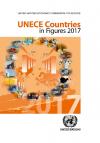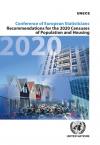Publications
Displaying Results 21 - 40 of 124
- English
This report reviews the situation and trends in progress towards the Sustainable Development Goals (SDGs) through the lens of 49 selected indicators under each of the 17 SDGs. Indicators were selected based on their relevance to the UNECE region and availability of data. For the most part, the report relies on the data available in the United Nations Global SDG Database as of 20 December 2019.
- English
Leading, composite and sentiment indicators make it possible for official statistics to shed new light on aspects of the economy and the society, for instance through compilation of leading indicators on the economic development or composite indicators measuring the well-being of households.This publication gives guidance to statistical offices that produce or consider producing leading,
- English
Official statistics are an indispensable element of the information system of democratic societies, serving governments, economies and the public with data that can help them understand and make decisions: about the economy, about the population, about society and the environment. An essential precondition for carrying out this task is a strong legal and institutional setting for
- English
UNECE Countries in Figures presents a profile of social and economic indicators for each of the 56 UNECE member countries.These profiles, prepared by the UNECE Statistical Division, are intended to be of interest to readers not necessarily familiar with statistical terminology or with interpreting statistical tables. A glossary of terms and list of references is available at the back of the
- English
The world is becoming more interconnected, with an acceleration in the movement of information, capital, goods, services and people across international borders. As it becomes easier to travel and work in other countries – especially in common market areas such as the European Union – the expansion of international labour mobility has become a topic of growing policy importance.International
- English
Migration shapes societies. Its economic, social and demographic impacts are large and increasing. Policymakers, researchers and other stakeholders need data on migrants – how many there are, their rates of entry and exit, their characteristics, and their integration into societies. These data need be comprehensive, accurate and frequently updated. There is no single source that can
- English
In a world where huge amounts of data are being generated all the time, and where citizens can look up almost anything they want, official statistics must stand out as a unique sourceof impartial and trustworthy information. The Fundamental Principles of Official Statistics – based on professional independence, scientific methods and rigorous quality criteria – give official statistics
- English
The purpose of this publication is to guide national statistical offices and other responsible agencies on the use of registers and administrative data in population and housing censuses, including operational, practical, technical and legal aspects.
The publication was prepared by a task force established by the Conference of European Statisticians (CES), composed of experts from
- English
This publication contains a series of good practices and recommendations on effectively communicating the results of population projections. Here, “communication” encompasses not only how projections should be disseminated to users, but also what should be communicated. The aim is to improve the coherence between what is produced by national statistical offices and what is needed by users,
- English
Conventional economic statistics, such as national accounts and employment measures, are largely designed to measure the market economy and in most countries exclude unpaid household service work. Economists have argued for many years that ignoring these services introduces biases in various areas of economic analysis. For instance, an increase in childcare or long-term care provided by the
- English
In the UNECE region, countries’ approaches to poverty measurement vary significantly. There is a large spectrum of poverty indicators, wide varieties of definitions, methods, thresholds and data sources that are not fully matched by national or international guidelines.This publication provides guidance on applying various measurement approaches and aims to improve the international
- English
The 2nd edition of the Road Map, published in February 2022, can be found here.
The publication provides guidance to national statistical offices on producing statistics for SDGs. It lays out what needs to be done, who are the stakeholders, and what are the opportunities for cooperation. The Road Map deals with
- English
UNECE Countries in Figures presents a profile of social and economic indicators for each of the 56 UNECE member countries.These profiles, prepared by the UNECE Statistical Division, are intended to be of interest to readers not necessarily familiar with statistical terminology or with interpreting statistical tables. A glossary of terms and list of references is available at the back of the
- English
The publication provides a recommendation and good practice guidance on a Generic Law on Official Statistics developed jointly with the European Free Trade Association and Eurostat as part of a broader UNECE statistical capacity building project financed through the United Nations Development Account. The guidance aims to support further development of the legal and institutional frameworks
- English
The idea of viewing individuals’ knowledge and abilities as an asset—as human capital—can be traced back to the 18th century. But human capital is hard to define and measure. Policymakers are calling for ways to understand and quantify human capital, in order to better understand what drives economic growth and the functioning of labour markets, to assess the long-term sustainability of
- English
Circular migration – a repetition of migration by the same person between two or more countries – is a topic of growing importance, on which information is needed for policy development. To meet this demand, tools must be established to better measure the extent to which existing international migration patterns become more (or less) circular over time and to evaluate policies aiming at
- Pусский
Миграция является мощным драйвером и важным следствием экономических, политических и социальных изменений. Поэтому ее необходимо соответствующим образом измерять и понимать. Тем не менее, совершенствование статистических систем по измерению миграции проходит медленно из-за слабого взаимодействия между производителями статистических данных по миграции, расхождениями в применяемых определениях и
- English
Migration is a powerful driver and important consequence of economic, political and social change, and therefore needs to be adequately measured and understood. However, the improvement of statistical systems to measure migration has been a slow process because of weak coordination between migration statistics producers, discrepancies in the applied definitions, and challenges related to data
- English
The population and housing census provides, at regular intervals, information on the number and characteristics of the population of a country, and on its housing stock. It is an essential source of information for small-area, national, regional and international planning and development. This publication reviews the practices followed by countries in Eastern Europe, Caucasus and Central
Conference of European Statisticians Recommendations for the 2020 Censuses of Population and Housing
- English
The main objectives of the Conference of European Statisticians Recommendations for the 2020 Censuses of Population and Housing are: to provide guidance and assistance to countries in the planning and execution of their population and housing censuses; and to facilitate and improve the comparability of census at the UN regional level through the identification of a core set of census topics






